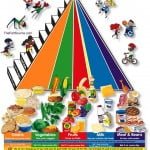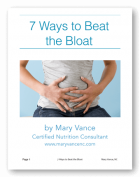Remember that little pyramid you saw in grade school nutrition class? You know, the USDA’s guidelines about what to eat? They are responsible, in part, for our country’s obesity epidemic/crisis. 60 percent of Americans are overweight, and although many admittedly aren’t concerned with structuring their diets in accordance with the USDA’s nutrition guidelines, the food industry is. And so if you’re buying a lot of processed, refined, packaged, or fast food, as many folks are, you are eating the pyramid.
Now, the USDA recently revised the pyramid and made some slight alterations, but the guidelines are basically the same: grains should be the base of your meal, followed by veggies & fruits, and 3 servings of milk and dairy. Meat, beans, and fats should be consumed in moderation.

Follow me and get fat!
Food is information for your body. If grains such as bread, pasta, corn, rice, and cereals are the base of every meal, you are spiking your insulin levels and telling your body to store more fat. Simple as that. In addition, because the food industry is following these guidelines and proudly slapping on their cereal boxes that you are getting X number of servings of “whole grains,” you are falling for it and snatching up those products in a effort to be healthy, according to the USDA anyway. For example, the first few ingredients of Cheerios are Whole Grain Corn, Whole Grain Oats, Sugar, Whole Grain Barley, Whole Grain Rice, Whole Grain Wheat, Corn Starch, Brown Sugar Syrup, Corn Bran: all corn and gluten-based grains. These grains are high on the glycemic index and spike your blood sugar (and the sugar doesn’t help either), causing more fat storage!
The fact is, every body is different and not all guidelines work for everyone. But even in general, I don’t agree with these guidelines, because physiologically speaking, grains should not be the focus of your diet: it should be proteins & vegetables. Grains cause a lot of problems with blood sugar, and those that contain gluten (wheat, rye, barley) can cause so many other problems, like digestive & hormonal issues. If you’re overweight or trying to lose weight, grains are the enemy.
Grains are actually a fairly recent introduction into our diets. Our ancestors survived on proteins, vegetables, fruits, nuts, and seeds. Grains can be difficult to digest and may contribute to Chron’s, IBS, reflux, gas, bloating, belching, and yeast overgrowth. In addition, with the dairy, I have to say that A) if you’re eating conventional dairy, you’re getting an unhealthy dosage of antibiotics & growth hormones, and B) dairy is the most common food allergy I see in my practice. Probably up to 80 percent of my clients are dairy sensitive and are unaware until I have them do food allergy elimination diets. And consuming foods to which you are allergic can have very detrimental effects on your health over time! Dairy also contributes to congestion & can make seasonal allergies much worse.
Back to the food pyramid. I disagree with eating so many servings of grains, 3 servings of dairy (good lord), and even so much fruit, which can be too sugar heavy for certain people. So let’s make our own food pyramid, yes?
Base of every meal should be veggies of all kinds, both raw and cooked, both starchy and leafy. Think kale, chard, spinach, broccoli, mixed greens, etc. Then add a small servings of starchier root veggies like beets, carrots, potatoes/yams, or winter squash. The next category should be clean, organic protein such as wild fish, poultry, beef, bison, lamb, or pork. You can also add beans or legumes. One to two servings of seasonal fruit daily is fine. Add about one tablespoon of fat per meal: this could be an avocado, or good fats such as olive oil, butter, coconut oil, or sesame oil. Maybe you cooked your veggie saute in the fat, or maybe it’s a salad dressing. A handful of nuts or seeds a day makes a good snack. And dairy, grains, and sweets should be consumed sparingly!
So there you have it: veggies, both starchy and low carb veggies; proteins/legumes/meats; fruits; good fats. If you are making meals at home, you are in control of your own food pyramid!

Mary Vance is a Certified Nutrition Consultant and author specializing in digestive health. She combines a science-based approach with natural therapies to rebalance the body. In addition to her 1:1 coaching, she offers courses to help you heal your gut and improve your health. Mary lives in San Francisco and Lake Tahoe in Northern California. Read more about her coaching practice here and her background here.






Wow talk about leading people astray! If everyone followed your advice there would be much less strain on the public health system and less people buying drugs to counteract all the problems, food for though?